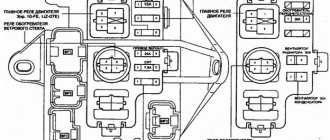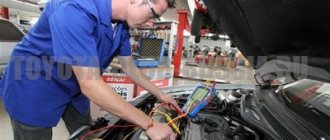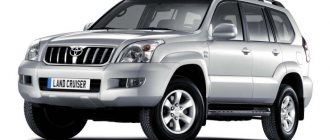Toyota Land Cruiser Prado cars are considered frame mid-size SUVs. The production of this model was carried out by the Japanese concern Toyota, which released the car back in 1987. Over the course of several years, several more generations of Toyota Land Cruiser Prado rolled off the assembly line, each of which was a more improved version. Today the car is still considered quite popular.
Like any other vehicle, the Toyota Land Cruiser Prado 150 has several fuse and relay blocks built into it, each of which is responsible for the operation of certain devices, sensors or systems. This article will discuss each of them, as well as provide instructions on how to replace the fuse in the event of a breakdown.
Fuse blocks
Fuses and relays are necessary in a car in order to ensure the safe and uninterrupted operation of devices, sensors and systems that are part of the electrical circuit.
The presence of these elements allows you to avoid sudden voltage surges with subsequent short circuits. Thus, the service life of the vehicle is significantly increased.
The Toyota Land Cruiser Prado 150 has two built-in fuse and relay blocks:
- Basic. Located under the hood of the vehicle. Sometimes this block is also called the motor block.
- Mounting. It can be found in the car interior.
Next, each of the blocks will be discussed in more detail.
Engine compartment
The Land Cruiser 100 fuse diagram located in the engine compartment includes:
- headlight control units (behind the headlights on the right and left, respectively);
- intake heater relay (middle of the engine compartment, closer to the left side);
- glow plugs (for diesel) (extreme right side of the engine compartment, flush with the intake heater relay);
- mounting block (under glow plugs);
- winch electric drive relay (slightly to the left of the mounting block, above the fuse links);
- fuse links (under the winch electric drive relay, to the left of the mounting block);
- headlight washer relay (to the right of the right headlight control unit).
On the Land Cruiser 100 mounting block there are also relays for the fuel pump, side lights, suspension adjustment and others. Their function is to open and close an electrical circuit.
In the engine compartment there is a mounting block with an impressive list of Land Cruiser 100 fuses:
- pump for gasoline or diesel;
- heated seats;
- stoves;
- fuel heater;
- headlight cleaner;
- motor control systems;
- sound signal;
- throttle control;
- alarm;
- direction indicators;
- central lock;
- window lift drive;
- rear window cleaner and defroster;
- fog lights;
- air conditioner;
- high and low beam;
- generator
So, if the fuel pump fuse of a Land Cruiser 100 breaks, the engine will not start: the car does not pump fuel into the highway, and without “blood”, which can be considered gasoline, the heart-motor will not beat.
Main unit
The main block contains most of the fuses and relays. They are responsible for the performance of many systems.
The location diagram is shown in the image below. Also, after the diagram there is a table showing a breakdown of the main elements of the unit.
| Designation | Purpose |
| 2 | Responsible for the operation of the RTS heater. |
| 5 | Controls the operation of the rear window heating. |
| 6 | Responsible for turning the rear fog lights on and off. |
| 12 | Provides timely and uninterrupted sound signal. |
| 20 | Controls the operation of the condenser fan. |
| 23,24 | Provides switching on and off of high beam headlights. |
| 26 | Responsible for the performance of the windshield wiper. |
| 34 | Regulates the operation of the fuel pump. |
The block also contains fuses and relays that ensure the functionality of towing the vehicle, are responsible for the lighting inside the car, and turn its side lights on and off.
Among other things, you can find elements with the help of which fuel injection is carried out, the starting system and navigation system come into operation. Finally, some of the elements of the block are designed to accommodate additional fuses if necessary.
A more detailed diagram is located under the cover of the main unit. Also, together, the car from the manufacturer is equipped with appropriate documentation, with the help of which you can find the necessary element and find out what it is responsible for.
Important!
Fuse sizes by color
Do you think that now you know everything and there won’t be any problems? Not so. Even people who know foreign languages well find it difficult to understand the complex technical terms printed as a reminder on the protective covers. If we add to this that one refractory insert can be responsible for several systems at once, then your optimism will be completely unfounded. But all is not lost. Let the detailed diagrams below be your guide. Before you start studying them, read some explanations:
There are four main fuse sizes. For ease of perception, they are color coded in accordance with the standard adopted by the manufacturers.
| Amps | Mini low | Mini | Reg | Maxi |
| 1 | .Black | |||
| 2 | Grey | Grey | Grey | |
| 3 | Violet | Violet | ||
| 4 | Pink | Pink | ||
| 5 | Tang | Tang | Tang | |
| 7,5 | Brown | Brown | Brown | |
| 10 | Red | Red | Red | |
| 15 | Blue | Blue | Blue | |
| 20 | Yellow | Yellow | Yellow | Yellow |
| 25 | Colorless | Colorless | Colorless | Grey |
| 30 | Green | Green | Green | Green |
| 35 | Blue-green | Brown | ||
| 40 | Orange | Orange | ||
| 50 | Red | |||
| 60 | Blue | |||
| 70 | Tang | |||
| 80 | Colorless | |||
| 100 | Violet | |||
| 120 | Purple |
- The fuses are marked with two color codes in the diagrams, which differ depending on the modification of the car or have two threshold values. Each case will be discussed separately in the description.
- There is no color designation if the number slot in the block is not used.
- Relays may also have color coding, but you should not rely on it, but on the serial part number.
Be sure to check out:
This information is important, since the use of fuses whose characteristics differ from the standard ones is unacceptable, as they can lead to serious damage.
Mounting block
This unit is located inside the Toyota Prado 150 car. You can find it under the dashboard, located on the driver’s side.
The layout of fuses and relays is shown in the image. After the image there is a table with a breakdown of the main elements.
| Designation | Purpose |
| 1 | Responsible for turning the cigarette lighter on and off, ensuring the operation of the socket in the car. |
| 2,13 | Responsible for the operation of the electric mirror motor, it also ensures the operation of the air conditioning system and audio system. |
| 3 | Responsible for turning on and off the reversing lights. |
| 12 | Ensures the functionality of fog lights. |
| 15 | Responsible for the vehicle starting system and supplying fuel to the fuel pump. |
| 17,27 | Organizes the operation of the electric power steering. It also ensures the functionality of the windshield wipers and regulates the steering and speed sensors. |
| 20 | Provides seat heating. |
| 24,25 | Regulates the operation of the electric window drive. |
| 32 | Responsible for illuminating switches and instrument panel. |
| 33 | Regulates the operation of side lights. |
Also, the fuses of this unit are responsible for the operation of devices and sensors inside the cabin.
Fuse links in the Prado 150 interior
In addition to the blocks under the hood, the Prado 150 has circuits in the interior . cabin box is a complex system under the panel on the driver's side (usually on the left). It provides many processes in conjunction with the circuitry under the hood. Below is a diagram of the arrangement of parts in the block.
1 – cigarette , as well as electrical socket . Elements 2 and 3 are distinguished by their versatility - they regulate many important systems, including of the rear-view mirrors air conditioning , audio system , navigation, parking assistance , reversing lights interactive car display and more. The fourth element is necessary for proper towing , the fifth regulates the air suspension . Number 8 is directly connected to the driver's seat , which is equipped with an electric drive. The ninth , as a rule, is activated in emergency situations; it is needed to lock doors and open the hatch . To regulate the position of the steering wheel, the eleventh works . Number 12 ensures safe movement in bad weather conditions and in conditions of poor visibility; it participates in the operation of fog lights .
14 – cabin air conditioner , 15 is necessary for proper operation of the starting system . Block parts with numbers 16 , 22 , 23 , 24 , 25 are car window lifters Element 16 is also multifunctional - it controls the operation of the gearbox , steering , steering wheel , automatic activation of the wipers , heated mirrors , and more.
17 and 19 are no less multifunctional - they ensure the operation of the gearbox , window wipers and steering , and are also necessary for the proper operation of the turn signals . The functionality of number 18 is similar to the previous ones. Electric fuse 20 provides heated car seats, 21 is directly connected to the electric drive of the front right seat, 26 – to the sunroof .
The operation of the windshield wipers is regulated the twenty- seventh element of the circuit, and the twenty- eighth works with cleaning the rear window . Fuse 31 ensures the safety of the devices . Circuits 30 , 32 , 33 are involved in many processes that occur in the car, including turning on the airbags , the intelligent and mechanical starting system, the steering , turning headlights and fog lights , the operation of the user display , rear-view mirror and more.
Replacing fuses
There are times when the voltage surge in the electrical circuit is so strong that the fuse cannot cope with its task and burns out. In this case, you will need to replace the part. Before starting the main work, it is recommended to take into account several rules:
- First of all, before replacing the fuse, you need to turn off the ignition and disconnect the battery terminals. This will ensure safe work – the car owner will not receive an electric shock.
- It is not recommended to replace the fuse with an element that is not suitable for its intended purpose and labeling. This can lead not only to a malfunction of the electrical circuit, but even to a fire of the entire machine.
- Replacement must be done using special tweezers. Also, do not use tools with metal tips, so as not to damage the integrity of the chain.
The sequence of actions for replacing the fuse is presented as follows:
- First turn off the ignition.
- After this, remove the block cover. To do this, you will need to use a special tool, since the cover is secured using screws and additional fixing elements.
- Then inspect the contents of the block for the presence of a faulty fuse. If there is one, its body will be darker than the rest. This is a sign that the fuse has blown.
- Using tweezers, remove the fuse from the block and install a new one in its place.
- Reinstall the cover.
- Connect the battery and turn on the ignition.
If the problem has been resolved, the car will work properly. Otherwise, it is recommended to seek help from professional technicians at a service station. It is worth noting that every vehicle owner can replace the fuse. The work is not difficult.
As a result, it should be said that the Toyota Prado 150 is a Japanese-made car with two fuse and relay blocks, each of which is equipped with several elements.
These parts ensure uninterrupted operation of the electrical circuits of devices, sensors and mechanisms of the entire vehicle. If a fuse or relay malfunctions, the element must be replaced immediately.
Fuses and relays Toyota Land Cruiser Prado | Base-ex
The ergonomics of the instrument panel and controls, as befits cars of this class, are not satisfactory: Excellent visibility is provided by a high seating position, huge rear-view mirrors and four or six all-round cameras are optional.
Instead of the eight seats of the previous generation, there are seven in the cabin of the new Prado and GX: The second row seat is now divided into three individual ones. The volume of an SUV's luggage compartment can vary from one liter to almost two cubic meters, obtained after folding the seats of the third row and, if necessary, the Toyota Prado cigarette lighter fuse.











